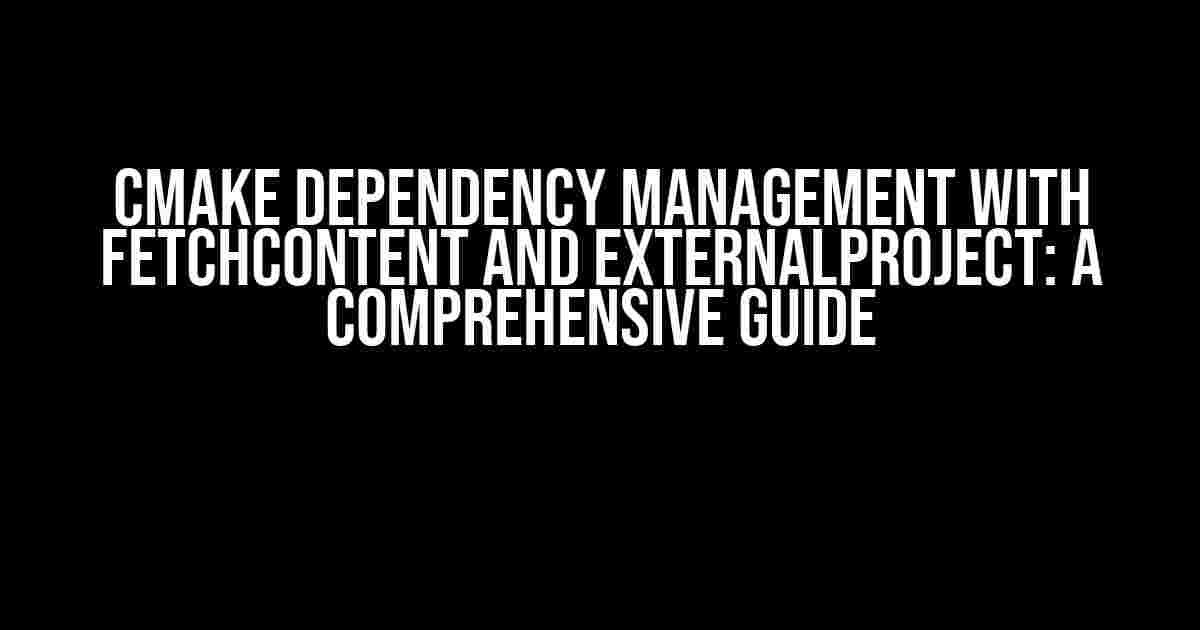Are you tired of dealing with tangled dependencies in your CMake projects? Look no further! In this article, we’ll dive into the powerful world of CMake dependency management using FetchContent and ExternalProject. Get ready to simplify your build process and streamline your project’s dependencies.
What’s the Problem?
Managing dependencies is a crucial aspect of building successful software projects. However, doing so can be a daunting task, especially when working with complex projects that rely on multiple libraries and frameworks. Without a solid dependency management strategy, you might find yourself wasting valuable time on:
- Manually downloading and installing dependencies
- Resolving version conflicts between dependencies
- Dealing with compatibility issues between different platforms
Enter FetchContent and ExternalProject
Fortunately, CMake provides two powerful modules to simplify dependency management: FetchContent and ExternalProject. These modules allow you to declaratively specify your project’s dependencies, ensuring that they’re downloaded, built, and installed automatically during the build process.
FetchContent: A Brief Introduction
FetchContent is a CMake module that enables you to download and extract content from external sources (e.g., Git repositories, archives, or websites) during the build process. This module is perfect for managing dependencies that don’t require building, such as data files, scripts, or other assets.
include(FetchContent)
FetchContent_Declare(
my_dependency
GIT_REPOSITORY https://github.com/user/my_dependency.git
GIT_TAG main
)
FetchContent_MakeAvailable(my_dependency)
ExternalProject: A Deeper Dive
ExternalProject is a more comprehensive CMake module that allows you to manage external projects as dependencies. This module provides a way to download, build, and install external projects, making it an ideal solution for managing complex dependencies that require compilation.
include(ExternalProject)
ExternalProject_Add(
my_dependency
GIT_REPOSITORY https://github.com/user/my_dependency.git
GIT_TAG main
CMAKE_ARGS -DCMAKE_BUILD_TYPE=Release
INSTALL_COMMAND ""
)
Using FetchContent and ExternalProject Together
When combined, FetchContent and ExternalProject provide a robust dependency management system. You can use FetchContent to manage non-buildable dependencies and ExternalProject to manage buildable dependencies. Here’s an example of how you might use both modules together:
include(FetchContent)
include(ExternalProject)
FetchContent_Declare(
my_data_files
GIT_REPOSITORY https://github.com/user/my_data_files.git
GIT_TAG main
)
FetchContent_MakeAvailable(my_data_files)
ExternalProject_Add(
my_library
GIT_REPOSITORY https://github.com/user/my_library.git
GIT_TAG main
CMAKE_ARGS -DCMAKE_BUILD_TYPE=Release
INSTALL_COMMAND ""
)
add_dependencies(my_library my_data_files)
Best Practices and Tips
To get the most out of FetchContent and ExternalProject, follow these best practices and tips:
- Keep your dependencies organized: Use separate directories for each dependency to avoid clutter and make it easier to manage dependencies.
- Use version control: Specify exact versions or Git tags to ensure reproducibility and avoid version conflicts.
- Define clear dependency relationships: Use the `add_dependencies` command to specify dependencies between projects, ensuring that they’re built and installed in the correct order.
- Cache dependencies: Use the `FetchContent` and `ExternalProject` modules with caching enabled to avoid re-downloading or rebuilding dependencies on subsequent builds.
- Monitor and debug dependencies: Use CMake’s built-in debugging tools, such as the `–debug-output` flag, to troubleshoot issues with dependencies.
Common Use Cases
FetchContent and ExternalProject can be applied to a wide range of scenarios, including:
| Use Case | Description |
|---|---|
| Library dependencies | Manage libraries used by your project, such as Boost, zlib, or OpenSSL. |
| Data files and assets | Fetch and manage data files, such as images, audio files, or configuration files. |
| Tools and executables | Manage external tools and executables required by your project, such as compilers, generators, or validators. |
| Test dependencies | Fetch and manage dependencies required for testing, such as test frameworks or mock libraries. |
Conclusion
In conclusion, FetchContent and ExternalProject are powerful CMake modules that simplify dependency management and streamline the build process. By following best practices and using these modules effectively, you can create robust and maintainable projects that are easier to manage and maintain.
Remember, dependency management is an essential aspect of software development. With FetchContent and ExternalProject, you can focus on writing code, not wrestling with dependencies.
Happy building!
Frequently Asked Question
Get the inside scoop on CMake dependency management with FetchContent and ExternalProject!
What is the main difference between FetchContent and ExternalProject in CMake?
FetchContent is used to download and extract content from a URL, whereas ExternalProject is used to build and install an external project. FetchContent is ideal for dependencies that don’t need to be built, such as header-only libraries or data files, while ExternalProject is better suited for dependencies that require building, like libraries that need to be compiled.
How do I specify the version of a dependency when using FetchContent in CMake?
You can specify the version of a dependency by using the `URL_HASH` argument with FetchContent. For example, `FetchContent_declare(mydep URL https://example.com/mydep-1.2.3.zip URL_HASH SHA256=…`)`. This ensures that the correct version of the dependency is downloaded and extracted.
Can I use FetchContent and ExternalProject together in a CMake project?
Yes, you can use both FetchContent and ExternalProject in the same CMake project. For example, you might use FetchContent to download and extract a header-only library, and then use ExternalProject to build and install a dependent library that requires compilation.
How do I handle errors and failures when using FetchContent or ExternalProject in CMake?
You can use the `DOWNLOAD_NO_EXTRACT` and `DOWNLOAD_NO_ERROR` arguments with FetchContent to control the behavior on download or extraction failures. For ExternalProject, you can use the `BUILD_IN_SOURCE` and `BUILD_IN_SOURCE_DIR` options to specify the build directory and control the build process. Additionally, you can use CMake’s built-in error handling mechanisms, such as `message(FATAL_ERROR …)` to abort the build process on errors.
Are there any best practices or guidelines for using FetchContent and ExternalProject in CMake projects?
Yes, some best practices include: using consistent naming conventions for dependencies, keeping the dependency versions up-to-date, using the `CMAKE_BUILD_TYPE` to control the build type, and using the `CMAKE_MODULE_PATH` to specify the module path for ExternalProject. Additionally, it’s recommended to keep the dependency management logic separate from the main build logic, and to use CMake’s built-in mechanisms for dependency management whenever possible.
